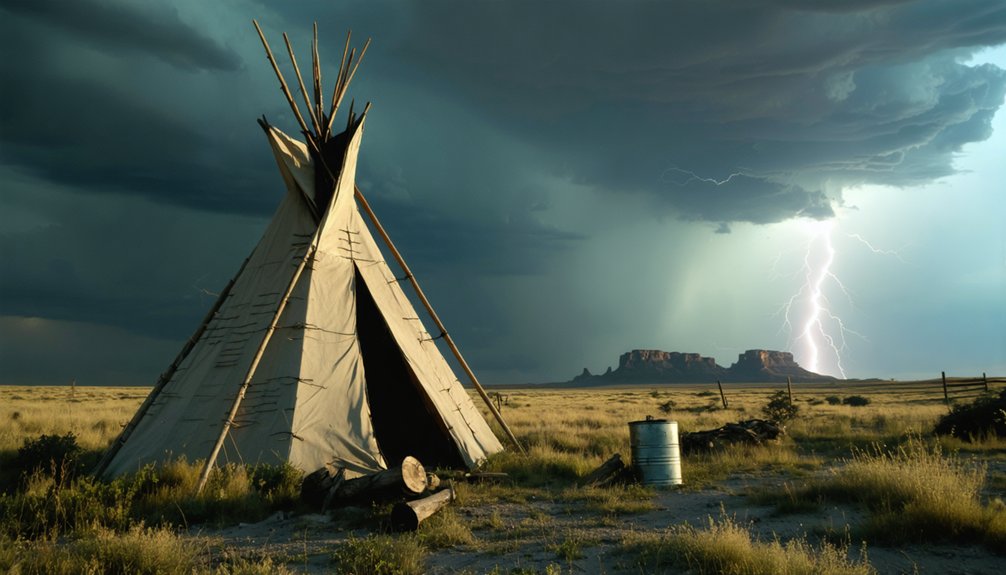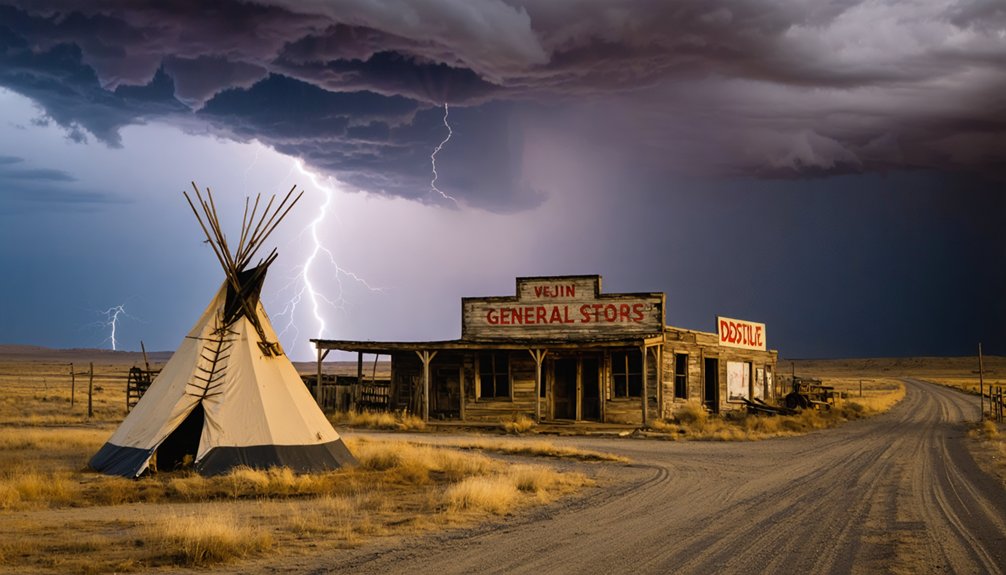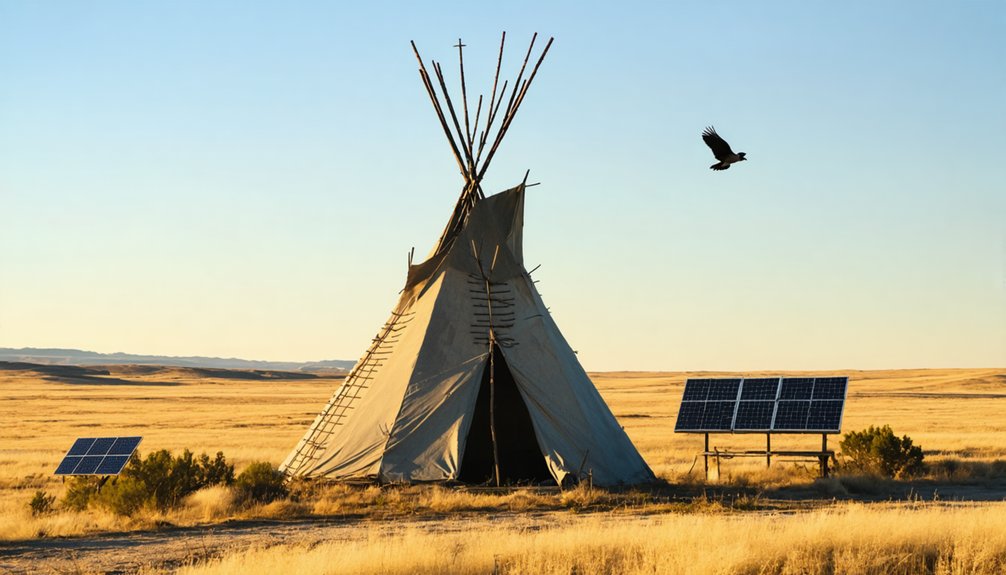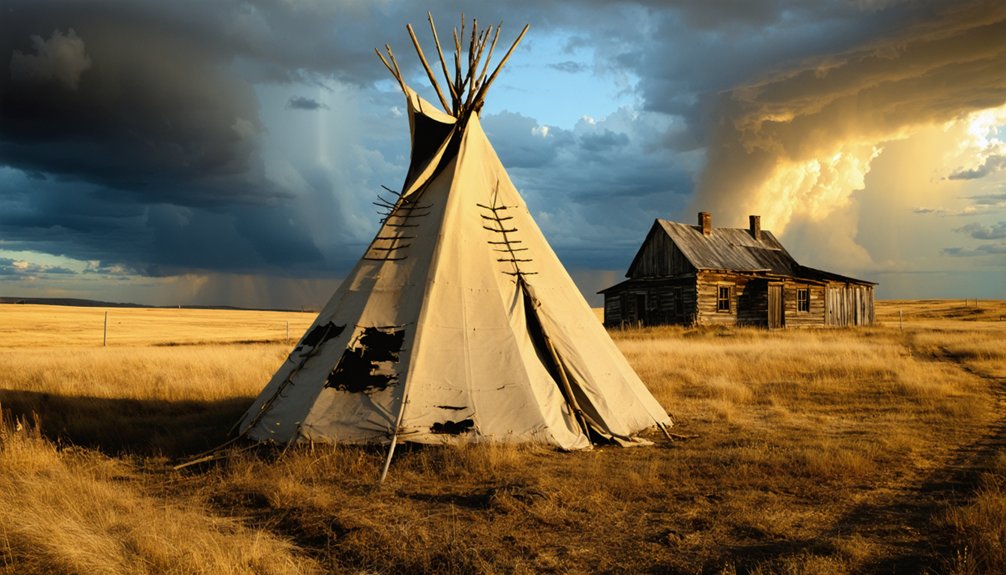You’ll find Tepee nestled in South Dakota’s Black Hills, where it emerged during the 1870s gold rush and lumber boom. The town thrived on sawmill operations, processing Ponderosa pine along the CB & Q Railroad line, while violating the Fort Laramie Treaty with the Lakota Sioux. Natural disasters, including devastating floods and the 1919 influenza outbreak, contributed to its decline. The foundations and remnants of this once-bustling settlement hold untold stories of frontier life.
Key Takeaways
- Tepee emerged during the 1870s mining boom after Custer’s expedition, developing around sawmill operations and the CB & Q Railroad.
- The town’s economy centered on lumber production, processing Ponderosa pine through multiple phases starting with Murphy’s sawmill in 1876.
- The settlement followed a T-shaped design with a railroad depot as its commercial center, featuring grain elevators and industry warehouses.
- Natural disasters, including devastating floods and the 1919 influenza outbreak, contributed significantly to the town’s eventual decline.
- Today, only foundations remain of the original structures, with access limited by private land ownership and minimal preservation funding.
The Rise and Fall of a Black Hills Settlement
While Native Americans had inhabited the Black Hills region for over 13,000 years, the settlement of Tepee emerged during the explosive growth of mining towns in the 1870s.
You’ll find its cultural significance deeply rooted in the region’s transformation after Custer’s 1874 expedition confirmed gold deposits, violating the Fort Laramie Treaty of 1868. Like nearby boomtowns Deadwood, Central City, and Lead, Tepee’s history reflects the dramatic shift from Native American territory to mining settlement. Prior to this shift, Grand Council leaders gathered at Bear Butte in 1857 to strategize against white intrusion into their lands. The Supreme Court later acknowledged the U.S. government’s dishonorable dealings with the Sioux in this territorial dispute.
The town’s development came at a heavy cost to the Lakota Sioux, who’d been guaranteed “absolute and undisturbed use” of these sacred lands.
As mining activities waned, Tepee gradually declined into ghost town status, joining other abandoned settlements that dot the Black Hills landscape – silent witnesses to the region’s complex past.
Life in Early Tepee: A Community Portrait
Three distinct characteristics defined daily life in early Tepee: the prevalence of sod-houses, tight-knit community bonds, and a robust cooperative spirit. You’d find these well-insulated sod dwellings dotting the landscape, offering protection against the region’s extreme temperatures and fierce blizzards.
The region’s typical Barnes-Parnell soil type made constructing these sod houses possible and practical. Community interactions centered around shared labor, with neighbors helping each other during harvests and building projects. The nearest general store served as a vital supply hub for rural farmers in the area. Agricultural practices dominated daily activities, as settlers worked the land under the Homestead Act while managing limited resources.
In this isolated settlement, you’d witness how geographical remoteness fostered deep social connections. Public gatherings and religious services weren’t just social events – they were essential lifelines that kept the community united.
Despite harsh conditions and resource limitations, settlers adapted through cooperative living and mutual support, creating a resilient community structure that defined early Tepee’s character.
Economic Foundations and the Sawmill Legacy
At the heart of Tepee’s economic vibrancy, you’ll find the sawmill operations providing essential employment while processing the region’s abundant Ponderosa pine.
You can trace the town’s strategic growth to its position along the CB & Q Railroad, which enabled efficient timber transport and broader market access.
Your understanding of Tepee’s development wouldn’t be complete without recognizing how the lumber industry fostered community expansion through jobs, infrastructure, and the critical materials needed for local construction.
Similar to the Holy Terror Gold Mine in nearby Keystone, dangerous working conditions were a constant concern for sawmill workers.
Timber sales agreements were established under Special Agent Greene, who arrived in 1897 to assess the area’s twelve operating sawmills.
Mill Operations and Employment
In the heart of South Dakota’s Black Hills, Tepee’s sawmill operations played a pivotal role in the region’s economic development during the late 19th and early 20th centuries.
You’d find workers earning around $3.00 per day, operating heavy equipment and managing timber logistics alongside specially trained horses for skidding logs.
As sawmill technology evolved from manual operations to industrial-scale facilities, the mills processed over a million board feet annually. The industry’s growth followed the example set by John Frances Murphy, who established the region’s first sawmill in 1876.
They’d grade and sort timber for various uses, from mine supports to furniture-grade lumber. The independent loggers were essential to maintaining forest health through selective thinning practices.
The industry created numerous jobs, from skilled sawyers to livery drivers, while major players like Homestake Mining Company dominated the market through strategic bidding on timber sales.
Workers adapted as modernization brought new equipment and methods, though the industry remained labor-intensive throughout its evolution.
Railroad Transport Networks
While South Dakota’s population barely exceeded 11,000 in 1880, the arrival of railroads transformed the region into a bustling hub of over 328,000 residents by 1890. The rapid development led to 285 frontier towns being established across the territory.
The rail infrastructure became crucial for Tepee’s sawmill operations, enabling efficient freight transportation of lumber products that would’ve been cost-prohibitive by wagon. The first narrow gauge railroad built in 1879 revolutionized local mining and lumber operations.
You’ll find the town followed a typical “T-shaped” design, with the depot serving as the commercial center.
- Chicago Northwestern and Deadwood Central lines provided essential passenger and freight service
- Rail sidings accommodated grain elevators and warehouses for multiple industries
- Depot areas became social and economic focal points for the community
- Branch lines extended specifically to serve remote sawmill operations
- The dense rail network created a complex matrix connecting mills, mines, and logging sites
Community Growth Through Lumber
Three distinct phases marked Tepee’s lumber industry evolution, beginning with John Frances Murphy’s pioneering sawmill establishment in nearby Custer during 1876.
You’ll find that early lumber production centered on harvesting Yellow Ponderosa pine for fort construction and settler homes, with sawmills quickly spreading to surrounding towns.
The second phase saw Homestake Mining Company’s dominance, which revolutionized the industry through regulated timber contracts and consolidated operations.
You’ll notice how their influence shaped market conditions and pricing throughout the region.
The final phase brought technological advancement, as manual labor gave way to mechanized felling and processing.
This evolution demonstrated remarkable community resilience, as sawmills became crucial economic anchors when mining activity waned, providing steady employment and expanding into secondary industries like particle board production.
Tales of Mystery and Local Legends

Legends surrounding the mysterious Tepee ghost town blend historical fragments with supernatural folklore, creating an enigmatic tapestry of frontier tales.
You’ll find that ghost stories and urban legends have flourished around this elusive settlement, though its exact location remains disputed. While no documented supernatural encounters exist specifically for Tepee, the region’s rich history of frontier justice and unexplained events has spawned numerous tales.
- Whispers of shadowy figures and unexplained sounds echo through historic buildings
- The Heppe murder case revealed how supernatural beliefs influenced frontier justice
- Local guides often weave stories connecting Native American heritage to the site
- The town’s strategic position along historic trails feeds into traveler’s tales
- Missing historical records have allowed folklore to fill the gaps in Tepee’s story
Transportation Networks and Trading Routes
As frontier commerce flourished in the Black Hills region, Tepee’s transportation networks evolved from early stagecoach routes to an interconnected system of trails and railways.
You’ll find that the town’s development was shaped by the Sidney-Deadwood Trail, which served as a crucial artery for freight transportation during the 1875-76 gold rush. Trail intersections near Tepee created natural stopping points, where roadhouses provided essential services to travelers and merchants.
When the Fremont, Elkhorn, and Missouri Valley Railroad expanded in the 1880s, it transformed the region’s transportation dynamics.
You’ll notice how the railroad’s arrival marked the decline of stagecoach routes, shifting commerce patterns and establishing new trade corridors. This change proved critical for many Black Hills communities, determining whether they’d thrive or fade into ghost towns based on their proximity to rail lines.
Natural Disasters and Town Decline

Tepee’s fate was sealed by devastating floods that damaged critical infrastructure, including the town’s lifeline railroad and the local sawmill that served as its primary employer.
The community’s attempts to rebuild were further hampered by the floods’ destruction of transportation routes and agricultural lands, which severely limited recovery options.
You’ll find that these natural disasters, combined with the influenza outbreak of 1919, accelerated population loss as residents sought more stable environments elsewhere, ultimately contributing to Tepee’s transformation into a ghost town.
Devastating Floods Strike
The catastrophic Black Hills-Rapid City Flood of 1972 dealt a devastating blow to towns like Tepee when intense rainfall released nearly 15 inches of water in just six hours.
The flood impact overwhelmed local infrastructure as Rapid Creek rose 13 feet in just five hours, with peak flows reaching 50,000 cubic feet per second. Community resilience was pushed beyond its limits as destructive floodwaters struck at midnight, catching residents unprepared.
- Floodwaters carried devastating debris including homes, vehicles, and exploding propane tanks
- Over 1,300 homes and 5,000 vehicles were destroyed across the region
- Total damage exceeded $160 million in 1972 dollars
- 238 people died and over 3,000 were injured
- Isolated communities like Tepee faced severe infrastructure damage, disrupting essential services
Community Recovery Efforts
Following devastating floods, numerous community-led recovery initiatives emerged to address both immediate disaster impacts and longer-term social challenges in the Tepee region.
You’ll find Indigenous-led efforts at the forefront, with the establishment of the Mni Luzahan Patrol and a tipi camp on tribal trust land near Rapid City. These community initiatives demonstrate cultural resilience through traditional approaches to healing and shelter.
The NDN Collective’s Landback campaign has reclaimed ancestral lands in the Black Hills, using ceremonies and community care to combat homelessness.
Federal support through increased Bureau of Indian Affairs funding has strengthened these efforts, while the Oglala Sioux Tribe’s Conservation Reserve Enhancement Program works to stabilize environmental conditions.
Local historical societies continue preserving the region’s heritage, maintaining important cultural sites despite ongoing challenges.
Accelerated Population Loss
Once a bustling frontier settlement, Tepee experienced catastrophic population loss due to overlapping economic and environmental disasters in the late 1800s.
The population patterns shifted dramatically as residents faced mounting challenges that made life in the town increasingly unsustainable. Social dynamics transformed from a thriving community to near abandonment as natural and economic forces converged.
- Severe droughts and devastating blizzards destroyed agricultural prospects and killed livestock
- Loss of mining, timber, and rail industries eliminated primary employment sources
- Infrastructure relocation cut off essential trade routes and regional connections
- Repeated environmental disasters forced ranchers and farmers to abandon their land
- Economic depression and resource depletion eliminated any chance of recovery
You’ll find few traces of Tepee’s original structures today, as most buildings have crumbled or burned, leaving only foundations to mark this once-prosperous settlement.
Modern-Day Exploration and Historical Preservation

Modern exploration of Tepee and other South Dakota ghost towns combines traditional fieldwork with technological advances, as researchers utilize GPS mapping, satellite imagery, and archival research to locate and document these forgotten settlements.
You’ll find local historical societies and museums serving as essential hubs for information, while explorers hike old railroad grades and search for building remnants.
Preservation efforts largely rely on grassroots initiatives, with amateur historians and local groups leading the charge to protect what remains.
While many structures have succumbed to time and weather, you’ll still discover foundations, ash heaps, and occasional standing buildings.
Access can be challenging, as some sites sit on private land, and limited funding means preservation depends heavily on volunteer dedication and landowner cooperation.
Frequently Asked Questions
Where Can Visitors Park When Exploring the Tepee Ghost Town Site?
You’ll need to find roadside pull-offs near the site, as there aren’t designated parking options. Follow visitor guidelines by avoiding private property and ensuring your vehicle doesn’t block local traffic.
Are There Any Dangerous Wildlife Encounters Reported in the Area?
You’ll need standard wildlife safety precautions when visiting, but there aren’t documented dangerous encounters. Watch for mountain lions, coyotes, and rattlesnakes, and maintain safe distances as encounter precautions.
What Items or Artifacts Can Legally Be Collected From Tepee?
Like a treasure hunter traversing a maze, you’ll need landowner permission to collect small, non-archaeological items. Legal guidelines restrict removal of architectural pieces, protected artifacts, or anything from historical registers.
Does the Site Require Permits or Permission for Photography?
You’ll need to follow standard photography guidelines for ghost towns on public lands. Basic snapshots don’t require permits, but commercial photography may face legal restrictions requiring proper authorization.
Which Seasons Offer the Best Conditions for Visiting Tepee?
With 85% of visitors choosing summer visits between May and September, you’ll find ideal conditions for exploration. Winter exploration is discouraged due to dangerous weather, making late spring through early fall your best timeframe.
References
- https://www.thesiouxempirepodcast.com/2020/10/halloween-2020-four-true-tales-of-south.html
- https://www.youtube.com/watch?v=_0WNYsFLSLA
- https://www.sdpb.org/rural-life-and-history/2023-08-21/some-black-hills-ghost-towns-and-their-origins
- https://www.youtube.com/watch?v=uCaj6m8TXv4
- https://www.southdakotamagazine.com/1880-town
- https://www.legendsofamerica.com/buffalo-gap-south-dakota/
- https://www.blackhillsbadlands.com/blog/post/old-west-legends-mines-ghost-towns-route-reimagined/
- https://en.wikipedia.org/wiki/List_of_ghost_towns_in_South_Dakota
- https://www.tripadvisor.com/LocationPhotoDirectLink-g54726-d622050-i373305127-South_Dakota_s_Original_1880_Town-Murdo_South_Dakota.html
- https://bbchp.org/portfolio/native-american-history/



